The Visayans (Visayan: Mga Bisaya; [mɐˈŋa bisɐˈjaʔ]) is an umbrella term for the Philippine ethnolinguistic groups native to the whole Visayas, to the southernmost islands of Luzon and to most parts of Mindanao. They are speakers of one or more Visayan languages, the most widely spoken being Cebuano and Hiligaynon (Ilonggo), closely followed by Waray-Waray. Many have, at some point in their lives, migrated to Metro Manila out of economic necessity brought about by centralization around it. They comprise the largest grouping in the geographical division of the country, numbering at around 33 million as of 2010.
Contents
- Categorizations
- Madja as Visayans
- Sugbu Visayans
- Terminology
- Classical period
- Spanish colonization
- Federal State of the Visayas
- American colonization
- Modern age
- Language
- Pre Christianity
- Present day
- Festivals
- Literature
- Cinema television and theatre
- Music
- Dance
- Visual arts
- References
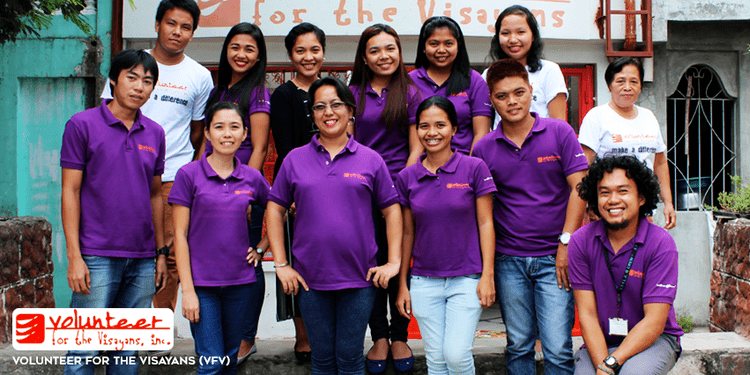
Categorizations
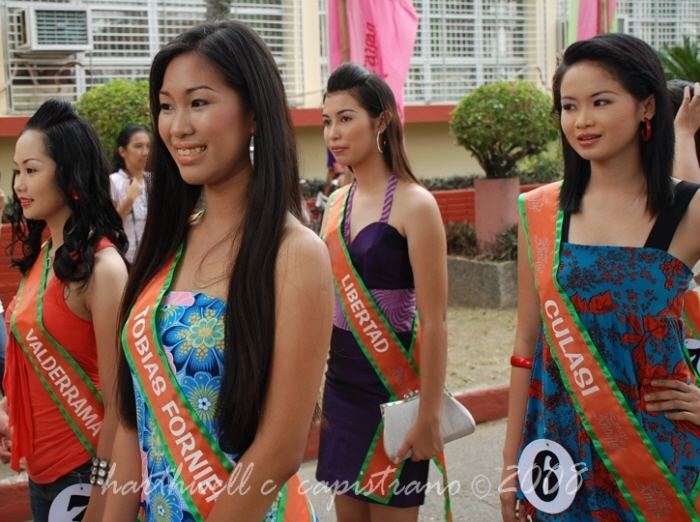
Filipino author and artist John Kingsley Pangan categorized the Visayans into two ethnolinguistic groups called the Madja-as Visayans and the Sugbu Visayans.
Madja-as Visayans
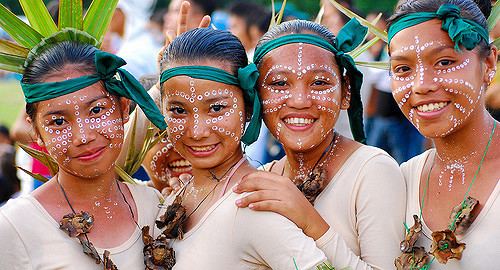
Madja-as Visayans are the ethnic group from the islands of Panay, Guimaras, Romblon and Negros Occidental, and other inhabitants who spoke the Hiligaynon (Ilonggo) language. The term comes from the confederacy of the aforementioned islands called Kedatuan of Madja-as. They originated also from the Austronesian aborigines and the Srivijayan empire, which in turn is said to be the origin word "Bisaya".

The colonizers also described these Visayans also as "white people, who have among them some blacks—the ancient inhabitants of the island" and not described as tattooed.
Sugbu Visayans
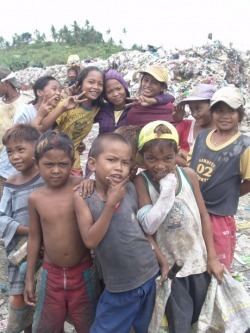
The Sugbu Visayans are the prominently known Visayans from Cebu, Bohol, Siquijor, Negros Oriental, Butuan, parts of Leyte and Samar, and other inhabitants who spoke the Cebuano language and were called by the early Spanish colonizers as Pintados (Painted Ones) since they were a heavily tattooed race. They originated from both the Austronesian aborigines and the Tamils through the Chola dynasty, who in turn first settled in Sugbu.
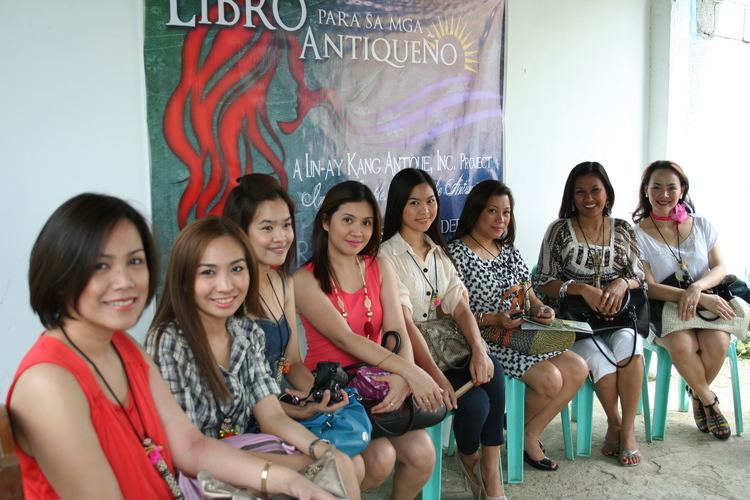
The Europeans described these Cebuano Visayans as tattooed “not because this is natural to them, although they are well built, of pleasing countenance, and white; but because they adorn their bodies with figures from head to foot, when they are young and have sufficient strength and energy to suffer the torment of the tattooing; and formerly they tattooed themselves when they had performed some act of valor.”
Terminology
Kabisay-an refers both to the Visayan people collectively and the lands they have inhabited since prehistory. The Anglicized term Visayas (adapted from the, in turn, Hispanized Bisayas) is commonly used to refer to the latter. The Visayan homeland—or the unofficial, precolonial Visayas—spans the following present-day Philippine provinces (from north to south, west to east within corresponding regions):
According to H. Otley Beyer and other anthropologists, the term Visayan (Spanish: bisayo) was first applied only to the people of Panay and to their settlements eastward in the island of Negros, and northward in the smaller islands, which now compose the province of Romblon. In fact, at the early part of Spanish colonialization of the Philippines, the Spaniards used the term Visayan only for these areas, while the people of Cebu, Bohol, and western Leyte were for a long time known only as Pintados. The name Visayan was later extended to them around the beginning of 1800s because, as several of the early writers state (especially in the writings of the Jesuit Lorenzo Hervás y Panduro published in 1801), albeit erroneously, their languages are closely allied to the Visayan "dialect" of Panay. The impression of these similarities was in fact carefully analyzed by David Zorc, who, while able to linguistically classify the Austronesian subfamily termed Visayan languages, noticed their overall connections as one dialect continuum. These should not, however, be confused as dialects, given the lack of mutual intelligibility.
Grabiel Ribera, captain of the Spanish royal infantry in the Philippine Islands, also distinguished Panay from the rest of the Pintados Islands. In his report (dated 20 March 1579) regarding a campaign to pacify the natives living along the rivers of Mindanao (a mission he received from Dr. Francisco de Sande, Governor and Captain-General of the Archipelago), Ribera mentioned that his aim was to make the inhabitants of that island "vassals of King Don Felipe ... as are all the natives of the island of Panay, the Pintados Islands, and those of the island of Luzon ..."
Classical period
The earliest settlements in the Visayan islands were from valley-dwelling Austronesians and highland-dwelling Negrito dated around 30,000 BC. These early settlers were mostly Animist tribes. In the 12th century, Hindu-Buddhist descendants from the late Śrīvijayan maṇḍala, Majapahit and Brunei, settled the islands. By the 14th century, Arab traders and their followers who ventured into Maritime Southeast Asia, converted some groups to Sunni Islam. Visayans practiced a mixture of Islamic, Hindu and Buddhist beliefs although there were also groups that were varied: some groups exclusively practiced Islam or Hinduism or Buddhism. There is also evidence of trade and immigration between other Asian peoples in the area as early as the 9th century. The Tumandok or Suludnon people of the mountainous region of Panay island are the only Visayan group to maintain pre-Hispanic Visayan culture and beliefs, due to their geographic isolation from lowland Visayan groups. One of the best preserved testimony of the antiquity of Panay civilization that was saved is the longest and oldest epic in the region, the Hinilawod, which must have been commonly known to the Visayans of Panay, since its main protagonists, like Labaw Donggon, were noted in the accounts of the Islanders' beliefs and oral tradition by early Spanish colonizers. One of this Westerner's account says that the adventures of this ancient hero of Panay was recalled during weddings and in songs.
Although dismissed as a hoax due to some content modifications, a compilation of transcriptions by Pedro Alcántara Monteclaro known as the Maragtas attempts to retell the origins of the present-day Visayan people based on folklore revolving around ten datus of Borneo. It was said that they originated from an area within the Śrīvijayan maṇḍala during the early 13th century. In an attempt to escape the despotic rule of a Rajah Makatunaw and the subsequent dissolution of the maṇḍala, the chieftains, led by Datu Puti (Malay: Datuk Putih), fled eastwards to what is now the island of Panay. The island at that time was ruled by an Ati chief Marikudo who was later given a golden sadok and a necklace for his wife, Maniwantiwan, in purchase of the Borneans of Panay for new settlement. It was said that the name for the inhabitants, Bisaya, was derived from their polity of origin, Śrīvijaya.
The Visayans first encountered Western Civilization when Portuguese explorer Ferdinand Magellan reached the island of Cebu in 1521. The Visayas became part of the Spanish colony of the Philippines and the history of the Visayans became intertwined with the history the Philippines. With the three centuries of contact with the Spanish Empire via Mexico and the United States, the islands today share a culture tied to the sea later developed from an admixture of India, indigenous lowland Visayans, Han Chinese, European culture in the Philippines and American influences.
Spanish colonization
The 16th century marks the beginning of the Christianization of the Visayan people, with the baptism of Rajah Humabon and about 800 native Cebuanos. The Christianization of the Visayans and Filipinos in general, is commemorated by the Ati-Atihan Festival of Aklan, the Dinagyang Festival of Iloilo, and the Sinulog festival the feast of the Santo Niño de Cebu (Holy Child of Cebu), the brown-skinned depiction of the Child Jesus given by Magellan to Rajah Humabon's wife, Hara Amihan (baptized as Queen Juana). By the 17th century, Visayans already took part in religious missions. In 1672, Pedro Calungsod, a teenage indigenous Visayan catechist and Diego Luis de San Vitores, a Spanish friar, were both martyred in Guam during their mission to preach Christianity to the Chamorro people.
By the end of the 19th century, the Spanish Empire weakened after a series of wars with its American colonies. The surge of newer ideas from the outside world thanks to the liberalization of trade by the Bourbon Spain fostered a relatively larger middle class population called the Ilustrados or "the Enlightened Ones." This then became an incentive for the new generation of educated political visionaries to fulfill their dreams of independence from three centuries of colonial rule. Some prominent leaders of the Philippine Revolution in the late 19th century were Visayans. Among leaders of the Propaganda movement was Graciano López Jaena, the Ilonggo who established the propagandist publication La Solidaridad (The Solidarity). In the Visayan theater of the Revolution, Pantaleón Villegas (better known as León Kilat) led the Cebuano revolution in the Battle of Tres de Abril (April 3). One of his successors, Arcadio Maxilom, is a prominent general in the liberalization of Cebu. Earlier in 1897, Aklan fought against the Spaniards with Francisco Castillo and Candido Iban at the helm. Both were executed after a failed offensive. Martin Delgado and Juan Araneta led the rebellion in neighboring Iloilo. With the assistance of Aniceto Lacson, Negros Occidental was freed. The latter would be called the Negros Revolution or the Cinco de Noviembre. The other half of Negros was rallied by Diego de la Viña. Movements in Capiz were led by Esteban Contreras with the aid of Alejandro Balgos, Santiago Bellosillo and other Ilustrados. Meanwhile, Leandro Locsin Fullon spearheaded the liberalization of Antique. Most of these revolutionaries would continue their fight for independence until the Philippine–American War. There was also a less heard and short-lived uprising called the Igbaong Revolt which occurred in Igbaong, Antique steered by Maximo and Gregorio Palmero. This revolt, however, was secularly-motivated as they clamored for a more syncretic form of religion based on Visayan animist traditions and Christianity.
Federal State of the Visayas
At the peak of the Philippine Revolution, anti-colonial insurgencies sprung from Luzon up to the Visayas. Despite military support from the Tagalog Republic led by Emilio Aguinaldo, Visayan revolutionary leaders were skeptical toward the real motives of the Tagalogs. Such ethnic animosity was notable to the point that local Visayan leaders demanded forces sent from the north to surrender their armaments and were prohibited to leave revolutionary bases. Moreover, this apprehension led to the full declaration of the Federal State of Visayas on December 12, 1898. This short-lived federal government, based in Iloilo, was an accumulation of revolutionary movements across Panay and Negros. The following were the elected officials four days prior to the declaration:
The federation was immediately formed upon the merger of the Cantonal Government of Negros, the Cantonal Government of Bohol and the Provisional Government of the District of Visayas (based in Panay) which included Romblon. It was said to be based on American federalism and Swiss confederacy. Despite their skepticism towards Malolos, the Visayan government proclaimed its loyalty to the Luzon-based republic while maintaining their own governance, tax collection and army. Apolinario Mabini, then the prime minister of the Malolos republic convinced the Visayan leaders that the Malolos Constitution was only provisional and that the governments in Visayas and Mindanao were promised the power to co-ratify it.
American colonization
After the 1898 Treaty of Paris, the American colonial government saw the integral part of indigenous elites particularly in Negros in local affairs. This was a different move compared to the previous Spanish imperialists who created a racial distinction between mestizos and native Austronesians (indios). As such, this paved the way for a homogenous concept of a Filipino albeit initially based on financial and political power. These said elites were the hacienderos or the landed, capitalist class concentrated within the sugar cane industry of Negros. The Americans' belief that these hacienderos would be strategic elements in their political hold within the newly acquired colony bolstered the drafting of a separate colonial constitution by and for the sugar industry elites. This constitution likewise established the Negros Cantonal Government. This ensured that the island of Negros would be governed by an indigenous civilian government in contrast to the rest of colonist-controlled areas governed by the American-dominated Philippine Commission.
During this period, the islands of Samar, Leyte and Biliran (including Marinduque) were directly governed by the Malolos Republic through Vicente Lukban and later by Ambrosio Mojica. Meanwhile, prior to the full abolition of the federal government on November 12, 1899, Emilio Aguinaldo appointed Martin Delgado as the civil and military governor of Iloilo on April 28, 1899 upon American invasion of Antique. The federal government, much to its rejection of the Cebuano leaders who supported the Katipunan cause, was dissolved upon the Iloilo leaders' voluntary union with the newly formed First Philippine Republic. Other factors which led to Aguinaldo forcing the Visayans to dissolve their government was due to the federation's resistance from reorganizing its army and forwarding taxes to Malolos.
Modern age
Since Philippine independence from the United States, there have been three Philippine Presidents from the Visayan region: the Cebuano Sergio Osmeña, the Capiznon Manuel Roxas and the Boholano Carlos P. García. In addition the Visayas has produced three Vice-Presidents, four Senate Presidents, eight Speakers of the House, six Chief Justices, and five Presidential Spouses including Imelda Marcos, a Waray. The then-president Gloria Macapagal Arroyo is also half Cebuano. Rodrigo Duterte has Cebuano roots, but he grew up in Mindanao. In international diplomacy the Visayas has produced a United Nations Undersecretary general, the Negros Occidental native Rafael M. Salas who served as the Head of the UNFPA. In the lines of religion, there have been two Visayan Cardinals, namely Julio Rosales from Samar and Jaime Sin from Aklan. The first Visayan and second Filipino that was canonized is Pedro Calungsod.
Throughout centuries, non-Visayan groups, most notably foreigners such as the Chinese, have settled in predominantly-Visayan cities in Visayas like Bacolod, Cebu and Iloilo and Mindanao such as Cagayan de Oro, Davao and General Santos. These Filipino-Chinese have been assimilated to mainstream society. One factor would be the limited number of Chinese schools in the Visayas which help maintain the Chinese identity and a stronger sense of a distinct community. Many of them, particularly the younger generation, have been de-cultured from Chinese traditions, share values about family and friends with other Filipinos, and do not write or speak Chinese well.
Meanwhile, Negritos, locally called Ati, have also been assimilated into mainstream Visayan society.
Visayans have likewise migrated to other parts of the Philippines, especially Metro Manila and Mindanao. The Visayans have also followed the pattern of migration of Filipinos abroad and some have migrated to other parts of the world starting from the Spanish and American period and after World War II. Most are migrants or working as overseas contract workers.
Language
Ethnic Visayans predominantly speak at least one of the Visayan languages which are commonly referred as Binisaya or Bisaya. The table below lists the Philippine languages classified as Visayan by the Summer Institute of Linguistics. Although all of the languages indicated below are taxonomically classified as Visayan, not all speakers identify themselves as ethnically Visayan. The Tausūg, a Moro ethnic group, only use Bisaya to refer to the predominantly Christian lowland natives which Visayans are popularly recognized as. This is a similar case to the Ati who delineate Visayans from fellow Negritos. Conversely, the Visayans of Capul in Northern Samar speak Abaknon, a Sama–Bajaw language, as their native tongue.
1 Philippines only.
2 Philippines only; 1,022,000 worldwide.
Pre-Christianity
Prior to the arrival of Catholicism, precolonial Visayans adhered to a complex animist system where spirits in nature were believed to govern all existing life. Similar to other ethnic groups in the Philippines such as the Tagalogs who believed in a pantheon of gods, the Visayans also adhered to deities led by a supreme being. Such belief, on the other hand, was misinterpreted by arriving Spaniards such as Jesuit historian Pedro Chirino to be a form of monotheism. There are Kaptan and Magwayan, supreme god of the sky and goddess of the sea and death, respectively. They in turn bore two children, Lihangin, god of wind, and Lidagat, goddess of the sea. Both aforementioned gods had four children namely Likabutan, the god of the world, Liadlaw, the god of the sun, Libulan, the god of the moon, and Lisuga, the goddess of the stars. People believed that life transpires amidst the will of and reverence towards gods and spirits. These deities who dwell within nature were collectively called the diwata. Meanwhile, spirits were referred to as umalagad (called anito in Luzon). These refer to ancestors, past leaders or heroes also transfigured within nature. Beside idols symbolizing the umalagad were food, drinks, clothing, precious valuables or even a sacrificial animal offered for protection of life or property. Such practice was a form of ancestor worship. Furthermore, these rituals surrounding the diwata and umalagad were mediated by the babaylan who were highly revered in society as spiritual leaders. These intercessors were equivalent to shamans, and were predominantly women or were required to have strong female attributes such as hermaphrodites and homosexuals. Old men were also allowed to become one. One notable example is Dios Buhawi who ruled a politico-religious revolt in Negros Oriental at the beginning of the Philippine Revolution.
Present-day
According to 2000 survey, 86.53% of the population of Western Visayas professed Roman Catholicism. Aglipayan (4.01%) and Evangelicals (1.48%) were the next largest groups, while 7.71% identified with other religious affiliations.
The same survey showed that 92% of household populations in Central Visayas were Catholics, followed by Aglipayans (2%) and Evangelicals (1%). The remaining 5% belonged to the United Church of Christ in the Philippines, Iglesia ni Cristo, various Protestant denominations or other religions.
For Eastern Visayas, 93% of the total household population were Catholics, while 2% identified as "Aglipayan", and 1% as "Evangelical". The remaining 15% belonged to other Protestant denominations (including the Iglesia ni Cristo, the Seventh-day Adventist Church, and various Baptist churches) or identified with Islam and other religions.
Festivals
Visayans are known in the Philippines for their festivities such as the Ati-atihan, Dinagyang, Pintados-Kasadyaan, Sangyaw, Sinulog festivals. Most Visayan festivals have a strong association with Roman Catholicism despite apparent integration of ancient Hindu-Buddhist-Animist folklore particularly the tradition of dances and the idols in the image of the Child Jesus commonly named as the Santo Niño. The oldest Catholic religious image in the islands still existing today is the Santo Niño de Cebú.
The Sandugo Festival of Tagbilaran, Bohol is a celebration of one of the most significant parts of pre-Philippine history. This festival revolves around the theme of the reenactment of the blood compact between the island's monarch, Datu Sikatuna, and the Spanish explorer, Miguel López de Legazpi, which is known among Filipinos as the Sandugo. The arrival of the ten Bornean datus as mentioned in the legend of Maragtas is celebrated in Binirayan Festival in Antique.
The MassKara Festival of Bacolod, Negros Occidental explores more on the distinct cultural identity of the city. Since Bacolod is tagged as the City of Smiles due to its fun-loving and enduring people, the city government inaugurated the festival in 1980.
Literature
Some of the earliest known works were documented by a Spanish Jesuit named Ignacio Francisco Alzina during the Spanish colonial Philippines. Among these literary pieces from ancient Eastern Visayas were candu, haya, ambahan, canogon, bical, balac, siday and awit which are predominantly in Waray. There were also narratives called susmaton and posong. It was also described that theater played a central role in performing poetry, rituals and dances. The Western Visayans also shared nearly the same literary forms with the rest of the islands. Among their pre-Hispanic works were called the bangianay, hurobaton, paktakun, sugidanun and amba. These were all found to be in Old Kinaray-a. Some of the widely known and the only existing literature describing ancient Visayan society are as the Hinilawod and the Maragtas which was in a combination of Kinaray-a and Hiligaynon. The Aginid: Bayok sa Atong Tawarik is an epic retelling a portion of ancient Cebu history where the Chola dynasty minor prince Sri Lumay of Sumatra founded and ruled the Rajahnate of Cebu. It also has accounts of Rajah Humabon and Lapu-Lapu.
It was found by Filipino polymath José Rizal in Antonio de Morga's Sucesos delas islas Filipinas that one of the first known native poet in much of pre-Philippines known to Europeans was a Visayan named Karyapa. During the golden age of native Philippine languages at the onset of Japanese occupation, numerous Visayan names rose to literary prominence. Acclaimed modern Visayan writers in their respective native languages are Marcel Navarra, the father of modern Cebuano literature, Magdalena Jalandoni, Ramon Muzones, Iluminado Lucente, Francisco Alvardo, Eduardo Makabenta, Norberto Romuáldez, Antonio Abad, Augurio Abeto, Diosdado Alesna, Maragtas S. V. Amante, Epifanio Alfafara, Jose Yap, Leoncio P. Deriada, Conrado Norada, John Iremil Teodoro and Peter Solis Nery.
Don Ramon Roces of Roces Publishing, Inc. is credited for the promulgation of Visayan languages in publications through Hiligaynon and Bisaya.
Cinema, television and theatre
Visayan films, particularly Cebuano-language ones, experienced a boom between the 1940s and the 1970s. In the mid 1940s alone, a total of 50 Visayan productions were completed, while nearly 80 movies were filmed in the following decade. This wave of success has been bolstered by Gloria Sevilla, billed as the "Queen of Visayan Movies", who won the prestigious Best Actress award from the 1969 FAMAS for the film Badlis sa Kinabuhi and the 1974 Gimingaw Ako. Caridad Sanchez, Lorna Mirasol, Chanda Romero, Pilar Pilapil and Suzette Ranillo are some of the industry's veterans who gained recognition from working on Visayan films.
The national film and television industries are also supported by actors who have strong Visayan roots such as Joel Torre, Jackie Lou Blanco, Edu Manzano, Manilyn Reynes, Dwight Gaston, Vina Morales, Sheryl Reyes, and Cesar Montano, who starred in the 1999 biographical film Rizal and multi-awarded 2004 movie Panaghoy sa Suba. Younger actors of Visayan origin or ancestry include Isabel Oli, Kim Chiu, Enrique Gil, Shaina Magdayao, Carla Abellana and Matteo Guidicelli.
Award-winning director Peque Gallaga of Bacolod has garnered acclaim from his most successful movie Oro, Plata, Mata which depicted Negros during World War II. Among his other works and contributions are classic Shake, Rattle & Roll horror film series, Scorpio Nights and Batang X.
GMA Network's 2011 period drama teleserye Amaya as well as its 2013 series Indio, featured the politics and culture of ancient and colonial Visayan societies, respectively.
Music
Traditional Visayan folk music were known to many such as Dandansoy originally in Hiligaynon and is now commonly sang in other Visayan languages. Another, although originally written in Tagalog, is Waray-Waray which speaks of the common stereotypes and positive characteristics of the Waray people. American jazz singer Eartha Kitt also had a rendition of the song in her live performances. A very popular Filipino Christmas carol Ang Pasko ay Sumapit translated by Levi Celerio to Tagalog was originally a Cebuano song entitled Kasadya Ning Taknaa popularized by Ruben Tagalog.
Contemporary Philippine music was highly influenced and molded through the contributions of many Visayan artists. Many of them are platinum recorder Jose Mari Chan, Pilita Corrales, Dulce, Verni Varga, Susan Fuentes, Jaya and Kuh Ledesma who have enjoyed acclaim around the 60's to the early 90's. Newer singers are Sheryn Regis and Sitti Navarro.
Yoyoy Villame, a Boholano, is dubbed as the Father of Filipino Novelty Songs with his Butsekik as the most popular. Villame often collaborated with fellow singer, Max Surban. Joey Ayala, Grace Nono and Bayang Barrios are some of the front-runners of a branching musical subgenre called Neotraditional which involved traditional Filipino instruments with modern rhythm and melody.
Rock emerged dominant in the Philippine music scene in the 80's. Among the bands from Visayas are Urbandub and Junior Kilat. Another subgenre also sprung a few years later called BisRock which is a portmanteau of Bisaya and rock.
Dance
Ethnic dances from the region are common in any traditional Filipino setting. Curacha or kuratsa (not to be confused with the Zamboangueño dish) is a popular Waray dance. Its Cebuano counterparts are kuradang and la berde. There is the liki from Negros Occidental and the well-known tinikling of Leyte. Other Hiligaynon dances are the harito, balitaw, liay, lalong kalong, imbong, inay-inay and binanog.
Visual arts
The only Boholano and the youngest to receive the National Artist of the Philippines award for visual arts is Napoleon Abueva. He is also tagged as the Father of Modern Philippine Sculpture. Among his works are Kaganapan (1953), the Transfiguration (1979) and the 14 Stations of the Cross around the EDSA Shrine. He is also responsible for the sculpture of the Sandugo monument at Tagbilaran City to give homage to his roots.
A renowned figure in architecture is Leandro Locsin of Silay, Negros Occidental. He was proclaimed as National Artist of the Philippines for architecture in 1990. Locsin worked on many of the buildings in many campuses of the University of the Philippines System. He also designed the main building or the Tanghalang Pambansa of the Cultural Center of the Philippines and the Ayala Tower One & Exchange Plaza housing the Philippine Stock Exchange at Makati.
